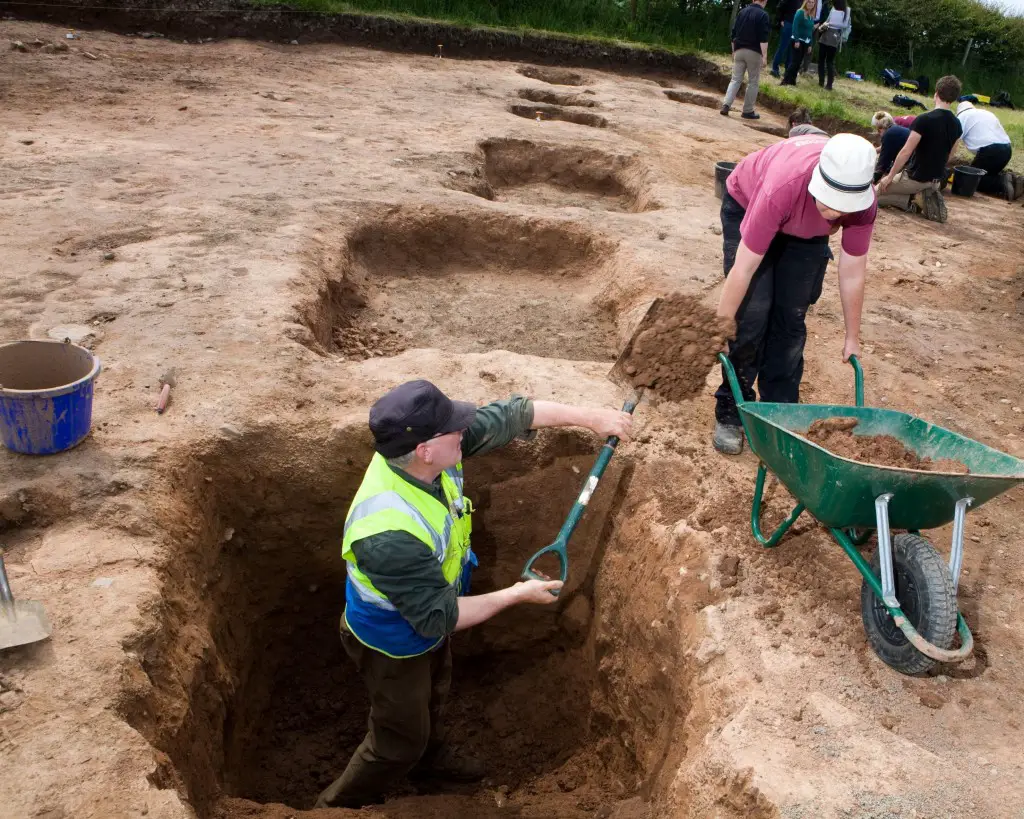L-R Nigel Mills of the Hadrian’s Wall Trust, Jane Laskey of the Senhouse Roman Museum, Tony Wilmott and Professor Ian Haynes
A team led by Newcastle University’s Professor Ian Haynes and Current Archaeology’s Archaeologist of the Year Tony Wilmott has started work in Maryport.
This year’s Maryport excavation is scheduled to run for 10 weeks on the Roman site which, last year, surprised and astonished the archaeological world. The country’s finest set of Roman military altars, dedicated by commanders from across the Roman empire, were discovered to have been buried in gigantic pits which underpinned a massive timber edifice, occupying the highest point of the ridge overlooking the Solway and Maryport’s Roman fort.
In 2011, only part of the ground-plan of the structure, or structures, built on the foundations of the second century altars was uncovered. This year’s work aims to establish the complete layout and to obtain what evidence survives regarding their precise dating and function.
The excavation is scheduled to be completed by Tuesday 14 August and will cost a little over £100,000, £60,000 of which is provided by the Senhouse Museum Trust which runs the Senhouse Roman Museum, while the remainder is contributed in kind by Newcastle University. The team includes archaeologists and students from Newcastle University and 42 local volunteers.
The site is part of the Hadrian’s Wall World Heritage Site and a scheduled ancient monument. It is owned by the Hadrian’s Wall Trust and is part of the proposed Roman Maryport heritage development.
Professor Ian Haynes said: “We are delighted to be excavating at Maryport again. The results of last summer’s research were exceptionally important.
“Until last year’s excavation it was accepted by Roman scholars worldwide that the 17 Maryport altar stones excavated in 1870 at the site – Britain’s largest cache of Roman altars – had been buried as part of a religious ceremony. It turns out they were re-used in the foundations of a large Roman timber building or buildings.
“This year we’re excavating over a larger area than last year – about 400 square metres – and for twice as long, which means we can involve more local volunteers, and learn more about the number of timber structures, their size and date.
“We need to find out what the buildings were used for and whether they and the curved ditch we discovered in 2011 have any relation to each other.
“We’re also looking for evidence on the techniques of earlier archaeologists working on the site.”

Hugh Thomson of the Senhouse Museum Trust said: “Maryport is a fascinating and important site and we are delighted to be able to fund this work by Ian Haynes, Tony Wilmott and their team for the second year.
”The main purpose of this excavation is to help us to understand the circumstances surrounding the burial of the internationally important group of altars which have been on display in the Senhouse Roman Museum since 1990. The results of the first season on the site surprised us all. This season’s work will enable us to learn more about the re-use of the altars in this extraordinary way and about the timber structure or structures which they appear to have supported.”
There is a well developed research framework for the site which identifies clear priorities for archaeological study and reflects the research strategies for the North West region and for the Hadrian’s Wall World Heritage Site.
The excavation is one of the key elements in a summer programme of activities at the Senhouse Roman Museum which includes something for everyone. There will be guided tours of the excavation, talks and lectures, finds handling and school visits.
Nigel Mills, director of world heritage and access for the Hadrian’s Wall Trust said: “The excavation is bound to attract lots of interest to Maryport again. We are looking forward to seeing this site develop over the years.
”More research is needed on Romano-British civilian settlements, and the geophysical surveys for Maryport commissioned by the Senhouse Museum Trust show that the settlement outside the Maryport fort was extremely complex, of considerable size and is well preserved.”
Evidence from Maryport and similar sites suggests these were multicultural settlements occupied by people from across the Roman Empire who earned their living managing supplies and services for the army and acting as middlemen for trade across the Empire.
Background:
The Hadrian’s Wall Trust is responsible for the care, protection, communications and management of the 150 mile Hadrian’s Wall World Heritage Site from the western Roman coastal defences at Ravenglass, Whitehaven, Workington and Maryport to Bowness-on-Solway, along Hadrian’s Wall through Carlisle and Hexham to Newcastle, Wallsend and South Shields.
There were over 30 forts on the Roman frontier across the north of England, including 16 along the line of the 73 mile Wall itself plus coastal, outpost and supply forts. Along the Wall there were around 80 milecastles and 160 turrets, a ditch to the north and the great defensive vallum earthwork to the south.
Hadrian’s Wall is also part of the first transnational World Heritage Site – Frontiers of the Roman Empire – which includes the Antonine Wall in Scotland and the German Limes. This represents the border line of the Roman Empire at its furthest extent in the 2nd century AD. It stretched from the west coast of northern Britain, through Europe to the Black Sea, and from there to the Red Sea and across North Africa to the Atlantic coast.
Contributing Source : Hadrian’s Wall Heritage
HeritageDaily : Archaeology News : Archaeology Press Releases






